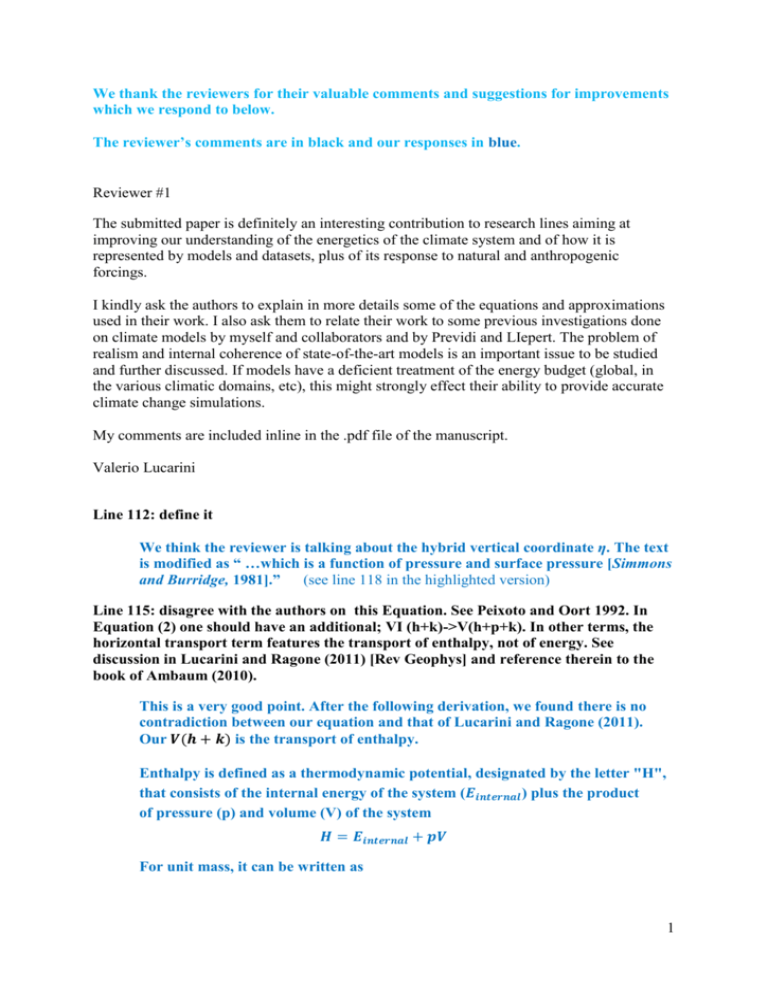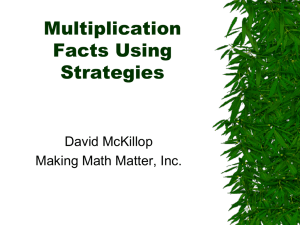We thank the reviewers for their valuable comments and
advertisement

We thank the reviewers for their valuable comments and suggestions for improvements which we respond to below. The reviewer’s comments are in black and our responses in blue. Reviewer #1 The submitted paper is definitely an interesting contribution to research lines aiming at improving our understanding of the energetics of the climate system and of how it is represented by models and datasets, plus of its response to natural and anthropogenic forcings. I kindly ask the authors to explain in more details some of the equations and approximations used in their work. I also ask them to relate their work to some previous investigations done on climate models by myself and collaborators and by Previdi and LIepert. The problem of realism and internal coherence of state-of-the-art models is an important issue to be studied and further discussed. If models have a deficient treatment of the energy budget (global, in the various climatic domains, etc), this might strongly effect their ability to provide accurate climate change simulations. My comments are included inline in the .pdf file of the manuscript. Valerio Lucarini Line 112: define it We think the reviewer is talking about the hybrid vertical coordinate η. The text is modified as “ …which is a function of pressure and surface pressure [Simmons and Burridge, 1981].” (see line 118 in the highlighted version) Line 115: disagree with the authors on this Equation. See Peixoto and Oort 1992. In Equation (2) one should have an additional; VI (h+k)->V(h+p+k). In other terms, the horizontal transport term features the transport of enthalpy, not of energy. See discussion in Lucarini and Ragone (2011) [Rev Geophys] and reference therein to the book of Ambaum (2010). This is a very good point. After the following derivation, we found there is no contradiction between our equation and that of Lucarini and Ragone (2011). Our 𝑽(𝒉 + 𝒌) is the transport of enthalpy. Enthalpy is defined as a thermodynamic potential, designated by the letter "H", that consists of the internal energy of the system (𝑬𝒊𝒏𝒕𝒆𝒓𝒏𝒂𝒍 ) plus the product of pressure (p) and volume (V) of the system 𝑯 = 𝑬𝒊𝒏𝒕𝒆𝒓𝒏𝒂𝒍 + 𝒑𝑽 For unit mass, it can be written as 1 𝒉=𝒆+ 𝒑 𝝆 where 𝝆 is the air density from the gas law 𝒑 = 𝝆𝑹𝑻, we have 𝒑 𝝆 = 𝑹𝑻 so 𝒉=𝒆+ 𝒑 = 𝒆 + 𝑹𝑻 𝝆 = (𝑳𝒒 + 𝑪𝒗 𝑻 + 𝒌 + 𝝋) + 𝑹𝑻 (where 𝒆 = 𝑳𝒒 + 𝑪𝒗 𝑻 + 𝒌 + 𝝋 is the internal energy) = 𝑳𝒒 + (𝑪𝒗 + 𝑹)𝑻 + 𝒌 + 𝝋 = 𝑳𝒒 + 𝑪𝒑 𝑻 + 𝝋 + 𝒌 = 𝒉+𝒌 where h = 𝑳𝒒 + 𝑪𝒑 𝑻 + 𝝋 as defined in the text. For 𝝋𝒔 in Eq (1), please see Trenberth and Solomon [1994], The global heat balance: heat transports in the atmosphere and ocean, Climate Dynamics (1994) 10:107-134. Line 126: Does this come from the fact that the pressure is normalized to 1? please explain. During the assimilation procedure, observations reset the surface pressure field, whereas the mass fluxes are not adjusted properly [Graversen et al., 2007] This is now added to the text. (see lines 132-134 in the highlighted version) Line 136: There is also horizontal water transport in other forms (clouds advection). Probably negligible, but should be mentioned. Agree. The text is modified. (see line 149 in the highlighted version) Line 137: Why is it more accurate? Water vapor is assimilated. Precipitation is a simulated variable that is highly dependent upon model parameterisations. This is mentioned in the text now. (see line 146 in the highlighted version) Line 142: I do not understand this equation, neither terms. Please explain This equation causes confusion and is removed. 2 Line 152: There is a basic problem in atmospheric models that the authors should consider. See Lucarini and Ragone 2011 Rev Geophys, Previdi and LIepert 2012, ERL Lucarini et al. 2014 Rev Geophys. Atmospheric models do not, in general, have a closed budget for the atmospheric energy, as a result of inconsistent treatment of a) turbulent cascade of kinetic energy b) inconsistent treatment of water mass. Line 176: See comment above. There are multiple problems with ERA-Interim energy budgets. This is a good comment. The text in the 1st paragraph of section 2.3 is modified to emphasis this point. (see lines 194-197 in the highlighted version) Line 188: Why? I do not understand. For energy conservation, we set the global mean energy divergence to zero, so top of atmosphere minus surface net energy fluxes equal atmospheric energy accumulation. Step (1) constrains the energy divergence over land, step (2) adjusts energy divergence over the global ocean to make sure the global energy conservation is satisfied (so there is no net energy generated). Line 237: What is the meaning of the bias term epsilon? what is its spatial structure? 𝜺 can be regarded as the energy flux penetrating beneath the surface layer. (added to line 226 in the highlighted version) As stated in the paper, we used the area mean climatology over the global land to do the regression, so for each month we have a pair of (𝑪, 𝜺). We also applied this method at each grid point (not shown in this paper), but it doesn’t make much difference to our mean results. Line 262: I guess this has to do with the surface albedo. After checking, we found the reviewer is correct. The net flux difference is mainly due to the albedo difference between the land and the ocean. This is mentioned in the text. (see line 285 in the highlighted version) Line 269-270: what is the reason for such a filter? A filter is necessary due to the noise generated by data assimilation, highlighting that spatial patterns must be interpreted with caution. (This is added to line 295 in the highlighted version) Line 280: Still. Differences of the order of 10-20 Wm^2 are present and should be mentioned. This is mentioned in the text now. (see line 301 in the highlighted version) 3 Line 288-289: Let's keep in mind that this number should be close to 0, or of the order of 1 W/m^2 This is mentioned in the text now. (see line 326 in the highlighted version) Line 345: The authors could easily produce a plot of changes in the large scale meridional heat transports. The meridonal transport and changes are shown in Fig. 4 now (new figure) and discussed in sections 3.2 and 3.3. (see lines 311-317 and lines 387-392 in the highlighted version) Line 409: I suggest the authors to comment their results in relation to Lucarini and Ragone 2011 nd Lucarini et al 2014, both Rev Geophys. They could check the agreement they get across the datasets on the meridional enthalpy transport. Good suggestion. The meridonal transport is plotted in Fig. 4 and comparisons are added in the text (sections 3.2 and 3.3). (see lines 311-317 and lines 387-392 in the highlighted version) 4 Reviewer #2 Review of “Combining satellite observations and reanalysis energy transports to estimate global net surface energy fluxes 1985-2012” by Liu et al (review by Michael Mayer, University of Vienna) The manuscript deals with the estimation of mean values and variability of net energy exchanges at the Earth’s surface. To circumvent known issues with parameterized fluxes from models, the authors compute the net surface energy exchange indirectly as residual from the atmospheric energy budget. The authors refine this well-established method for the estimation of surface flux by adjusting surface fluxes over land to balance observed surface temperature changes. The adjustment over land in return helps to bias-correct the results over the ocean. Using a new dataset of reconstructed TOA radiation covering 1985-2012 (recently published by Allan et al 2014) and ERA-Interim data for the divergence of atmospheric transports (computed by the authors in two different ways) and energy tendencies, the resulting surface flux estimates appear to be quite stable in time and suitable for investigation of interannual variations. To me the most interesting result is the comparison of net surface flux of the periods 2001-2008 and 1986-2000. The found differences between the two periods are very different to the results from AMIP5 simulations. This is an interesting finding in spite of the ongoing climate warming hiatus and the discussion where the extra heat is entering the ocean. As in my opinion this is a main point of the paper and opposite to model results, the robustness of this result has to be shown, at least by using an additional atmospheric reanalysis. Moreover, the second method to estimate surface fluxes needs improvement (see specific comments). The present manuscript includes at least some novel aspects regarding methodology, but the second method to compute the atmospheric divergence has shortcomings that should be improved. Moreover, the results are certainly interesting, but they have to be corroborated with additional datasets to make them more credible. Apart from this, the language is clear and figures are well-prepared. I recommend publication of the manuscript after major revisions. Major comments: 1) The method to compute Fmass is straight-forward and seems good to me. Yet, your method to compute Fres seems flawed to me. If I understand correctly, analysed energy tendencies are employed in equation (8). Then, if you insert (8) into (9), this yields: Fres=FS-ERA+(FT-Allan-FT-ERA). This would mean that you adjust the modeled surface fluxes from ERA-I only by the difference between FT from ERA-I and Allan et al. This is insufficient to correct biases in FS-ERA as they are certainly not entirely reflected in FT-ERA. As you already follow Mayer et al (2012) for computation of EDmass, I suggest to follow also their method for computation of EDres by using (mass-adjusted) forecast energy tendencies in equation (8). This yields two improvements: First, the global mean values of EDres will be much closer to zero as the forecast tendencies balance the unrealistic global mean values of FT-ERA and FS-ERA. Using analysed tendencies leads to projection of FT-ERA and FS-ERA biases onto EDres, which is certainly not desirable. Second, equation (8) would implicitly include analysis increments after insertion of equation (9): Fres=FS-ERA+(FT-Allan5 FTERA)+(dE/dtforecast-dE/dtanalysed). I believe this would improve this method quite substantially. Regarding EDres you should emphasize that this field is computed from model forecasts in contrast to EDmass, which relies on analysed atmospheric state quantities. Many thanks for this constructive comment and we agree that the forecasted total energy tendency should be used in Eq. 8 (Eq 7 in the revised version). The forecasted total energy tendency is now used and the corresponding Figures are re-plotted. All related texts are revised. 2) The large differences found between AMIP5 and your results when comparing the periods 2001-2008 and 1986-2000 seem very interesting to me. However, you have to show that this is a robust finding. As the divergence of atmospheric energy transports mostly defines the structure of the fields shown in Fig. 5, I suggest corroborating the results by employing another atmospheric reanalysis, e.g. MERRA or JRA-55 for computation of Fmass. Mass-adjustment works differently for these reanalyses, but is certainly doable. I believe that this would help a lot to make this important finding more credible. The mass adjusted energy divergence from the MERRA reanalysis is also used now to compute the net surface flux. Some similarities in the spatial patterns of changes are identified in the eastern Pacific yet the analysis indicates that the detailed structure of the changes in surface fluxes are uncertain and further analysis is required to demonstrate robust signals. This caveat is now discussed in the text. (see line 298 and lines 358-360 in the highlighted version) Minor comments: Line 130: E is here used as abbreviation of evaporation but E is already used for total energy in line 124. Many thanks for spotting this, the evaporation E is changed to Evap. Line 138: It is correct that equation (5) neglects ice, but it does only deal with water mass and not with energy as erroneously stated. Agree. The “energy change ” has been changed to “water mass transfer”. (see line 147 in the highlighted version) 6 Line 153: Here you should cite earlier studies which already employed this method, e.g.Trenberth et al 1997 and many older studies cited therein or also Mayer et al 2014. Done. (see line 167 in the highlighted version) Line 156: what is the forecast range of the flux fields? 6-, 12, 24-hourly? The forecast range of the flux is 12 hours which is consistent with the calculation of forecasted energy tendency from ERA-Intrim data. Line 163: write what equation (9) gives after insertion of (8) – see also major comments Done. The complete equation including analysis increment is in Eq. 8 now. Line 171: this is exactly the point where it might help to include analysis increments in EDres – otherwise errors in fluxes e.g. from missing aerosol forcing will project onto EDres. Agree. The text is modified accordingly. (see line 187 in the highlighted version) Line 178: could you quantify these changes, e.g. by giving RMS values of the difference fields over land? Done. The RMS over land is given now. (see line 199 in the highlighted version) Line 185: why do you explicitly write 2D here? Text is modified and the 2D is deleted. (see lines 206-213 in the highlighted version) Lines 197-198: unclear - write explicitly what you adjust: model forecasts of FS from ERA-Interim. Text is modified. The detailed descriptions of this method can be found in the next section. (see line 219 in the highlighted version) Lines 211-212: not clear – write that you employ regression to get a monthly climatology for C. The text is modified to make it clear. (see lines 235-237 in the highlighted version) Line 213: what does reconstructed mean? Reconstructed from dT/dt, C and epsilon? “Reconstructed” is from dT/dt, C and 𝜺. The text is modified to make it clear. (see line 237 in the highlighted version) 7 Line 251: note here that FT-Allan is not entirely independent of FT-ERA. Hence, it is not surprising that correlation between these two datasets is highest. The spatial structure is not independent, but the area mean time series is adjusted to satellite observations, so it is independent. Line 263: 2012 instead of 2011 Corrected. Line 351: I believe you mean changes of latent heat flux, not of latent heat. “latent heat” is changed to “latent heat flux”. (see line 398 in the highlighted version) Line 356: how much value have the area-averaged correlation coefficients in spite of the very large spatial differences between AMIP5, UPSCALE and your surface fluxes shown in Fig. 5? I would find maps of local correlation coefficients a valuable addition, at least in the supplements. This is a good idea. 2D correlation coefficient maps between Fmass and other data sets are added to the supplementary material (Fig. S4). Line 371: 2012 instead of 2011 All are corrected. Lines 401-403: yes, please do so already in this paper – see major comments. MERRA data set is added. Time series plots: annotate the right axes with units of petawatts to make land and ocean values better comparable Plots with time series (Figs. 2 and 6 ) are modified with the left y-axis in unit of W/m2 and the right y-axis in unit of PW. Figure 3: maybe you should mention in the text that the UPSCALE fluxes over land are almost as bad as ERA-Interim fluxes (-069 versus 0.71 Wm-2); I also believe there are some issues with the masking of the UPSCALE fields, e.g. the land curve shows very strong negative values around 50S. This is mentioned in the text. (see lines 308-310 in the highlighted version) After using a new land mask obtained from soil moisture grid points, the large values around 50S are still there. So it may be the model problem near the coast. 8 Figure 4: give RMS values for all difference fields; give units in label bar RMS value for each map is given at the top right corner (Fig. 5 now). Unit is added to the end of the color bar. Figure 5: why are the fields so noisy although you employ spatial filtering? Can this be realistic? At least note the noise in the text. Only Dmass is filtered. The noise in Southern Ocean in panels b-e may be the artifact of the ellipse map. Wider color bar range will make the plot better looking but will make TOA flux map too light. So the current plot is kept. It is noted in the text. (see line 359 in the highlighted version) Language: Line 65: …we apply an atmospheric… Line 153: delete last the of the line Line 196: unrealistic instead of unrealistically Line 226: …using the above method… Done. 9








